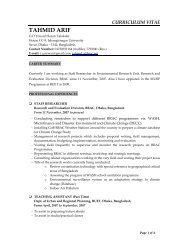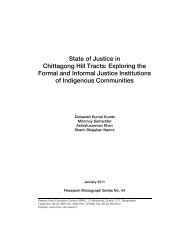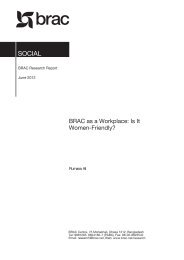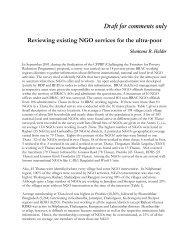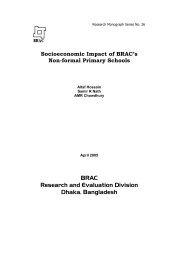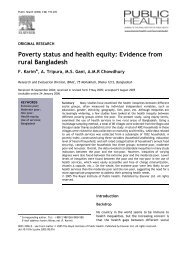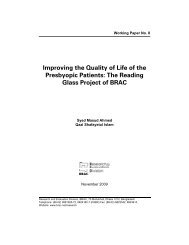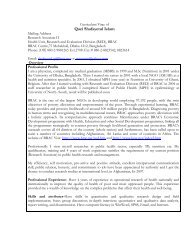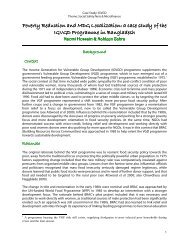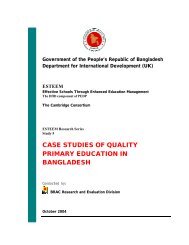Combining health and social protection measures to reach the ultra ...
Combining health and social protection measures to reach the ultra ...
Combining health and social protection measures to reach the ultra ...
You also want an ePaper? Increase the reach of your titles
YUMPU automatically turns print PDFs into web optimized ePapers that Google loves.
Decision-making<br />
Global <strong>and</strong> regional mortality in 2001<br />
Slightly more than 56 million people died in 2001, 10.5<br />
million, or nearly 20%, of whom were children younger than<br />
five. Of <strong>the</strong>se child deaths, 99% occurred in low- <strong>and</strong> middleincome<br />
countries. Those age 70 <strong>and</strong> over accounted for 70%<br />
of deaths in high-income countries, compared with 30% in<br />
o<strong>the</strong>r countries. Thus a key point is <strong>the</strong> comparatively large<br />
number of deaths among <strong>the</strong> young <strong>and</strong> <strong>the</strong> middle-aged in<br />
low- <strong>and</strong> middle-income countries. In <strong>the</strong>se countries, 30% of<br />
all deaths occur at ages 15 <strong>to</strong> 59, compared with 15% in<br />
high-income countries. The causes of death at <strong>the</strong>se ages, as<br />
well as in childhood, are thus important in assessing public<br />
<strong>health</strong> priorities.<br />
Trends in mortality levels<br />
The 1990s were characterized by significant economic gains<br />
in most regions, with growth in gross national product per<br />
capita ranging from 18% in South Asia <strong>and</strong> sub-Saharan<br />
Africa <strong>to</strong> more than 100% in East Asia <strong>and</strong> <strong>the</strong> Pacific <strong>and</strong><br />
<strong>the</strong> Middle East <strong>and</strong> North Africa. Overall, gross national<br />
product per capita grew by about 33% in low- <strong>and</strong> middleincome<br />
countries during <strong>the</strong> decade. One would expect this<br />
<strong>to</strong> have led <strong>to</strong> a significant improvement in life expectancy,<br />
<strong>and</strong> this indeed occurred in most regions with <strong>the</strong> notable<br />
exception of Europe <strong>and</strong> Central Asia <strong>and</strong>, in particular, sub-<br />
Saharan Africa (Table 1a <strong>and</strong> 1b). In <strong>the</strong> former region, life<br />
expectancy was largely unchanged at around 72.5 years over<br />
<strong>the</strong> decade, primarily because of <strong>the</strong> massive rise in adult<br />
mortality in countries such as Russia <strong>and</strong> its neighbours<br />
during <strong>the</strong> first part of <strong>the</strong> decade, which negated <strong>the</strong> declines<br />
in child mortality. Much of this extraordinary increase in adult<br />
mortality, which rose by about 50% between 1987 <strong>and</strong><br />
1994, has been attributed <strong>to</strong> alcohol abuse, particularly<br />
among men (Leon et al. 1997).<br />
Economic development <strong>and</strong> better coverage of <strong>the</strong><br />
population with essential child <strong>health</strong> services have ensured<br />
continued declines in levels of child mortality, as measured by<br />
<strong>the</strong> risk of death from birth <strong>to</strong> age five, in all regions. The<br />
notable exception is sub-Saharan Africa, where child<br />
mortality among girls remained unchanged at around 165<br />
per 1000, with only a modest decline (5%) in <strong>the</strong> risk of<br />
death for boys. The absence of significant declines in child<br />
mortality in <strong>the</strong> 1990s in sub-Saharan Africa is most likely<br />
largely due <strong>to</strong> <strong>the</strong> impact of HIV/AIDS. Overall, <strong>the</strong> risk of<br />
child death declined from 90 per 1000 in 1990 <strong>to</strong> 80 per<br />
1000 in 2001, with <strong>the</strong> risk being remarkably similar for<br />
males <strong>and</strong> females (Table 1a <strong>and</strong> 1b); however, <strong>the</strong> differential<br />
in child mortality between <strong>the</strong> world’s richest <strong>and</strong> poorest<br />
populations is stark, with a newborn in sub-Saharan Africa<br />
facing 25 times <strong>the</strong> risk of death before <strong>the</strong> age of five than a<br />
newborn in a high-income country.<br />
Despite <strong>the</strong> much greater uncertainty in relation <strong>to</strong> levels of<br />
adult mortality compared with those for children, <strong>the</strong><br />
estimates shown in Table 1a <strong>and</strong> 1b none<strong>the</strong>less indicate<br />
substantially different trends in adult mortality across different<br />
regions between 1990 <strong>and</strong> 2001. For most regions, <strong>the</strong> risk<br />
of death between ages 15 <strong>and</strong> 60 fell by about 10 <strong>to</strong> 17%<br />
over <strong>the</strong> decade. This was not <strong>the</strong> case in Europe <strong>and</strong> Central<br />
Asia, where policy shifts, particularly in relation <strong>to</strong> alcohol,<br />
<strong>to</strong>ge<strong>the</strong>r with broader <strong>social</strong> change, have largely been<br />
responsible for <strong>the</strong> 15% rise in adult male mortality <strong>and</strong> <strong>the</strong><br />
6% increase in <strong>the</strong> risk of death for women. Note that <strong>the</strong>se<br />
estimates mask <strong>the</strong> large cyclical fluctuations in adult<br />
mortality in Russia, in particular, that characterized <strong>the</strong><br />
region’s mortality trends in <strong>the</strong> 1990s.<br />
Table 1 also reveals <strong>the</strong> large increase in adult mortality in<br />
sub-Saharan Africa, which was due primarily <strong>to</strong> <strong>the</strong> unfolding<br />
of <strong>the</strong> HIV/AIDS epidemic in sou<strong>the</strong>rn Africa. Notwithst<strong>and</strong>ing<br />
<strong>the</strong> substantial uncertainty surrounding <strong>the</strong>se estimates, <strong>the</strong><br />
epidemic appears <strong>to</strong> have been of proportionately greater<br />
consequence for women, with <strong>the</strong> rise in <strong>the</strong>ir risk of death<br />
(67%) being twice that of males, among whom o<strong>the</strong>r causes<br />
of death such as violence were more common. If <strong>the</strong>se<br />
estimates are correct, <strong>the</strong>n 52% of African males <strong>reach</strong>ing<br />
age 15 <strong>and</strong> 44% of females will die before <strong>the</strong>ir 60th<br />
birthdays, compared with, for instance, 6.5% of women in<br />
high-income countries, who despite <strong>the</strong>ir already low risk<br />
enjoyed a fur<strong>the</strong>r 11% decline in mortality during <strong>the</strong> 1990s.<br />
These reversals in mortality decline have effectively negated<br />
gains elsewhere, with <strong>the</strong> results that <strong>the</strong> global risk of adult<br />
death has remained essentially unchanged for males, <strong>and</strong><br />
may even have risen slightly for females.<br />
Taken <strong>to</strong>ge<strong>the</strong>r, <strong>the</strong> probability of death up <strong>to</strong> <strong>the</strong> age of five<br />
<strong>and</strong> between <strong>the</strong> ages of 15 <strong>and</strong> 60 are a better reflection of<br />
<strong>the</strong> risk of premature death than ei<strong>the</strong>r alone, although both<br />
have particular public <strong>health</strong> implications. Some argue that<br />
<strong>health</strong> policy should be equally concerned with keeping<br />
adults alive in<strong>to</strong> old age as it is with keeping children alive<br />
in<strong>to</strong> adulthood. A convenient metric <strong>to</strong> measure this is <strong>the</strong> risk<br />
of death between birth <strong>and</strong> age 60 (Table 1a <strong>and</strong> 1b). In<br />
high-income countries, given 2001 mortality rates, only<br />
about 7% of females <strong>and</strong> 13% of males would be dead by<br />
age 60, compared with 55 <strong>to</strong> 62% in sub-Saharan Africa.<br />
Significant improvements in this summary measure of<br />
premature death can be observed in all regions except Europe<br />
<strong>and</strong> Central Asia <strong>and</strong> sub-Saharan Africa. Worldwide, <strong>the</strong><br />
index appears <strong>to</strong> have changed slightly for males <strong>and</strong> not at<br />
all for females.<br />
O<strong>the</strong>r features of global mortality summarized in Table 1a<br />
<strong>and</strong> 1b are worth highlighting. First is <strong>the</strong> impressive<br />
evidence of a continued decline in mortality among older age<br />
groups in high-income countries that began in <strong>the</strong> early<br />
1970s. The risk of a 60-year-old dying before age 80<br />
declined by about 15% for both men <strong>and</strong> women in highincome<br />
countries so that at 2001 rates, fewer than 33% of<br />
women who <strong>reach</strong> age 60 will be dead by age 80, as will less<br />
than 50% of men. Second, crude death rates in East Asia <strong>and</strong><br />
<strong>the</strong> Pacific, Latin America <strong>and</strong> <strong>the</strong> Caribbean, <strong>and</strong> <strong>the</strong> Middle<br />
East <strong>and</strong> North African region are lower than in high-income<br />
countries, reflecting <strong>the</strong> impact of <strong>the</strong> older age structure of<br />
rich countries, <strong>and</strong> are particularly low in Latin America <strong>and</strong><br />
<strong>the</strong> Caribbean. Third, <strong>the</strong> proportion of deaths that occur<br />
below age five, while declining in all regions, varies<br />
enormously across <strong>the</strong>m, from just over 1% in high-income<br />
countries <strong>to</strong> 44% in sub-Saharan Africa. In some low- <strong>and</strong><br />
middle-income regions, particularly East Asia <strong>and</strong> <strong>the</strong> Pacific,<br />
166 ✜ Global Forum Update on Research for Health Volume 4




